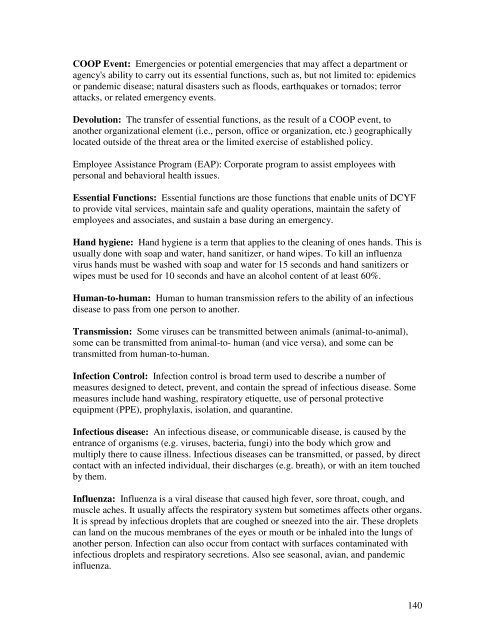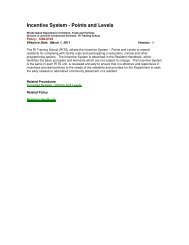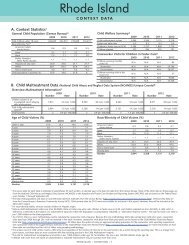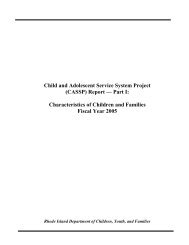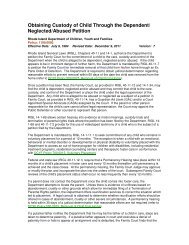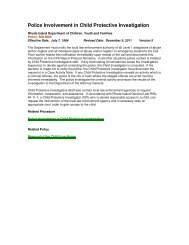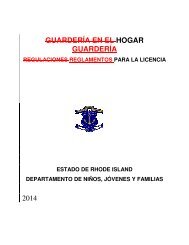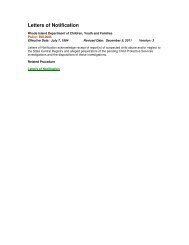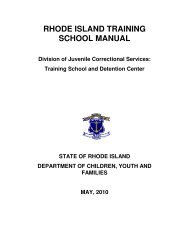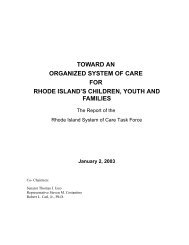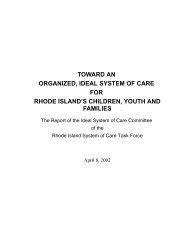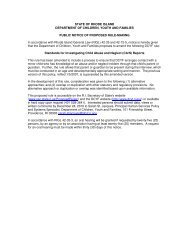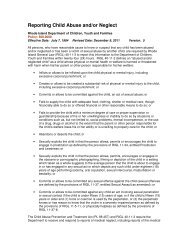CFSP 5 Year Plan - RI Department of Children, Youth & Families
CFSP 5 Year Plan - RI Department of Children, Youth & Families
CFSP 5 Year Plan - RI Department of Children, Youth & Families
Create successful ePaper yourself
Turn your PDF publications into a flip-book with our unique Google optimized e-Paper software.
COOP Event: Emergencies or potential emergencies that may affect a department or<br />
agency's ability to carry out its essential functions, such as, but not limited to: epidemics<br />
or pandemic disease; natural disasters such as floods, earthquakes or tornados; terror<br />
attacks, or related emergency events.<br />
Devolution: The transfer <strong>of</strong> essential functions, as the result <strong>of</strong> a COOP event, to<br />
another organizational element (i.e., person, <strong>of</strong>fice or organization, etc.) geographically<br />
located outside <strong>of</strong> the threat area or the limited exercise <strong>of</strong> established policy.<br />
Employee Assistance Program (EAP): Corporate program to assist employees with<br />
personal and behavioral health issues.<br />
Essential Functions: Essential functions are those functions that enable units <strong>of</strong> DCYF<br />
to provide vital services, maintain safe and quality operations, maintain the safety <strong>of</strong><br />
employees and associates, and sustain a base during an emergency.<br />
Hand hygiene: Hand hygiene is a term that applies to the cleaning <strong>of</strong> ones hands. This is<br />
usually done with soap and water, hand sanitizer, or hand wipes. To kill an influenza<br />
virus hands must be washed with soap and water for 15 seconds and hand sanitizers or<br />
wipes must be used for 10 seconds and have an alcohol content <strong>of</strong> at least 60%.<br />
Human-to-human: Human to human transmission refers to the ability <strong>of</strong> an infectious<br />
disease to pass from one person to another.<br />
Transmission: Some viruses can be transmitted between animals (animal-to-animal),<br />
some can be transmitted from animal-to- human (and vice versa), and some can be<br />
transmitted from human-to-human.<br />
Infection Control: Infection control is broad term used to describe a number <strong>of</strong><br />
measures designed to detect, prevent, and contain the spread <strong>of</strong> infectious disease. Some<br />
measures include hand washing, respiratory etiquette, use <strong>of</strong> personal protective<br />
equipment (PPE), prophylaxis, isolation, and quarantine.<br />
Infectious disease: An infectious disease, or communicable disease, is caused by the<br />
entrance <strong>of</strong> organisms (e.g. viruses, bacteria, fungi) into the body which grow and<br />
multiply there to cause illness. Infectious diseases can be transmitted, or passed, by direct<br />
contact with an infected individual, their discharges (e.g. breath), or with an item touched<br />
by them.<br />
Influenza: Influenza is a viral disease that caused high fever, sore throat, cough, and<br />
muscle aches. It usually affects the respiratory system but sometimes affects other organs.<br />
It is spread by infectious droplets that are coughed or sneezed into the air. These droplets<br />
can land on the mucous membranes <strong>of</strong> the eyes or mouth or be inhaled into the lungs <strong>of</strong><br />
another person. Infection can also occur from contact with surfaces contaminated with<br />
infectious droplets and respiratory secretions. Also see seasonal, avian, and pandemic<br />
influenza.<br />
140


